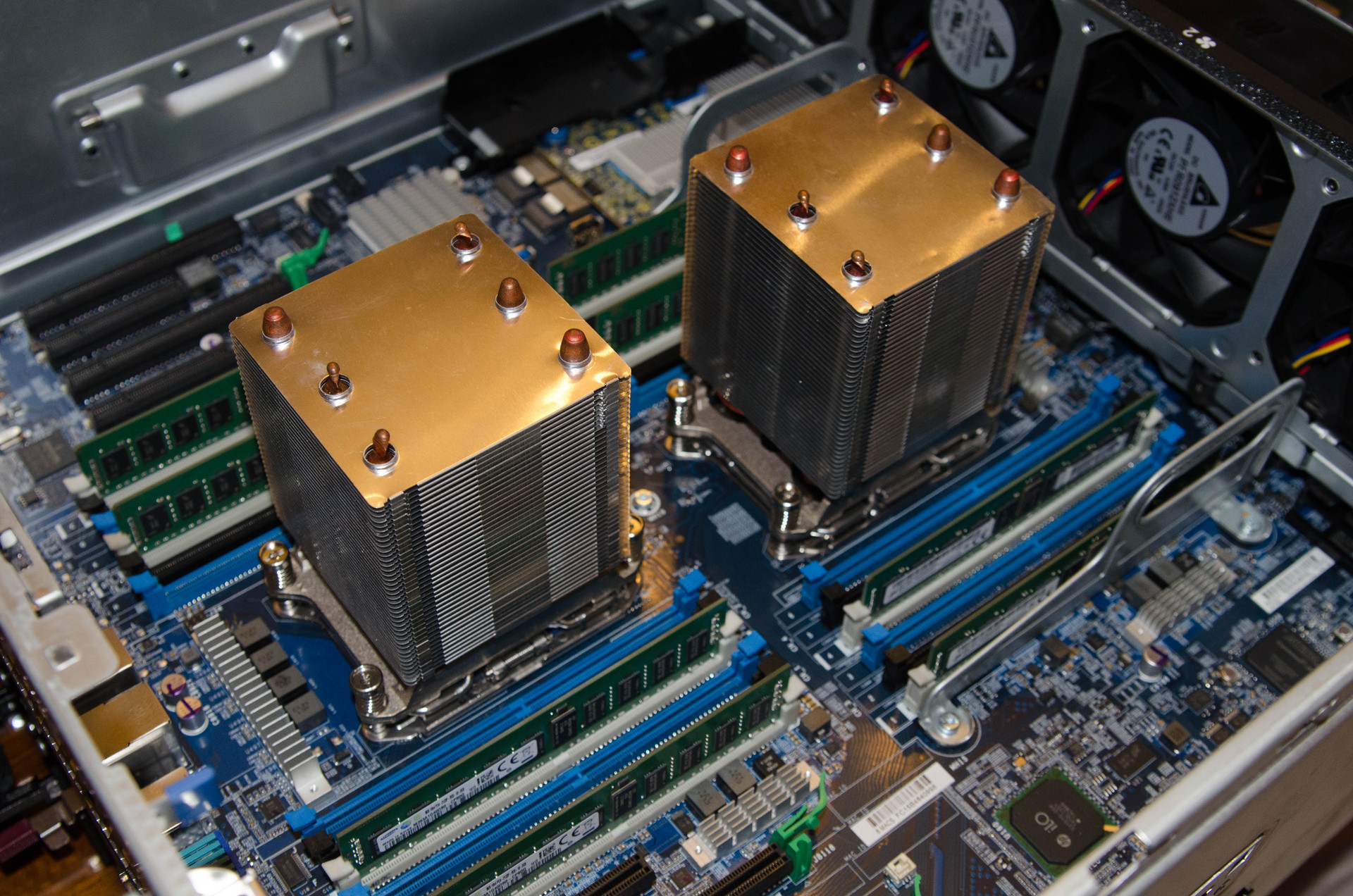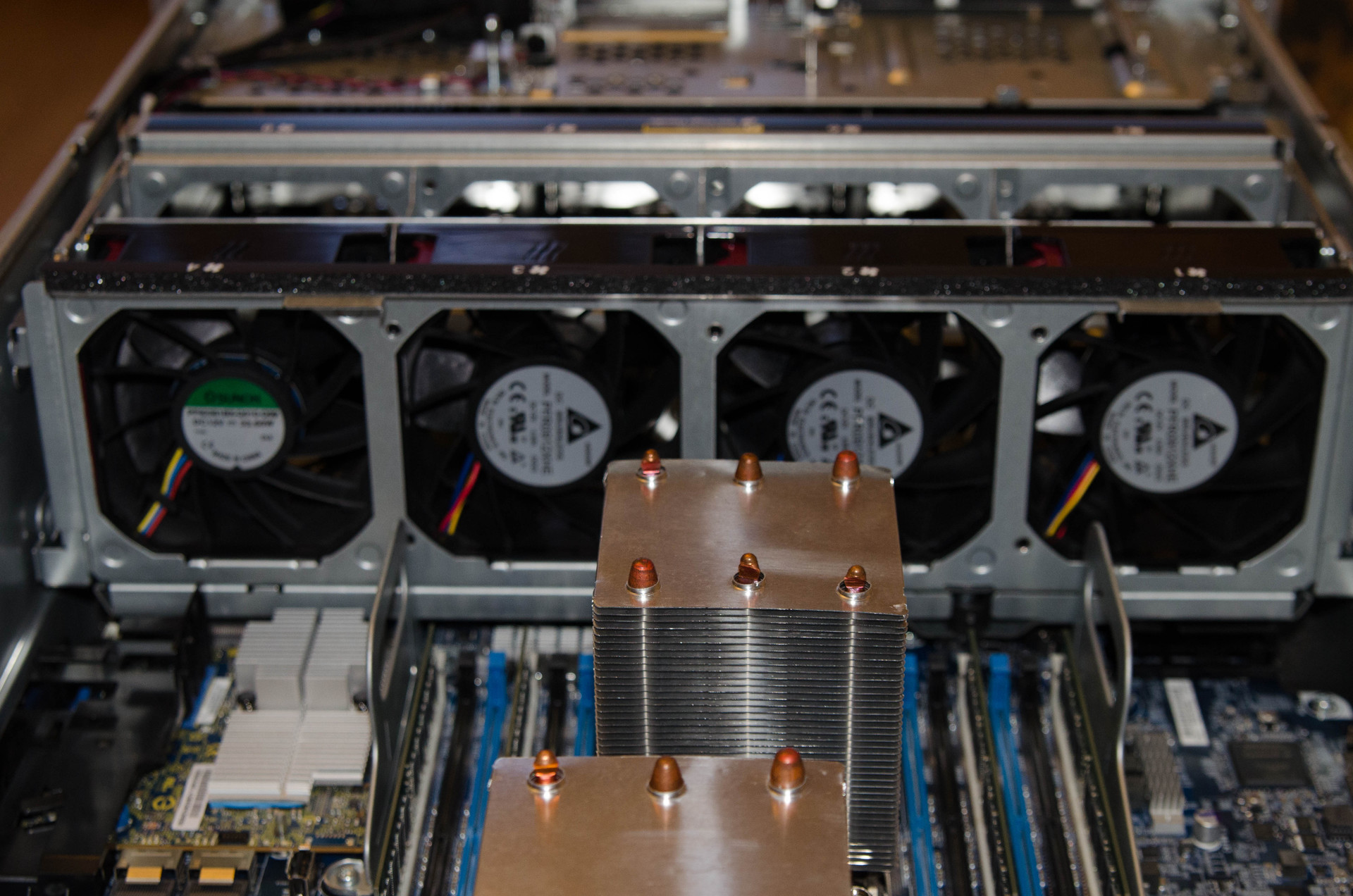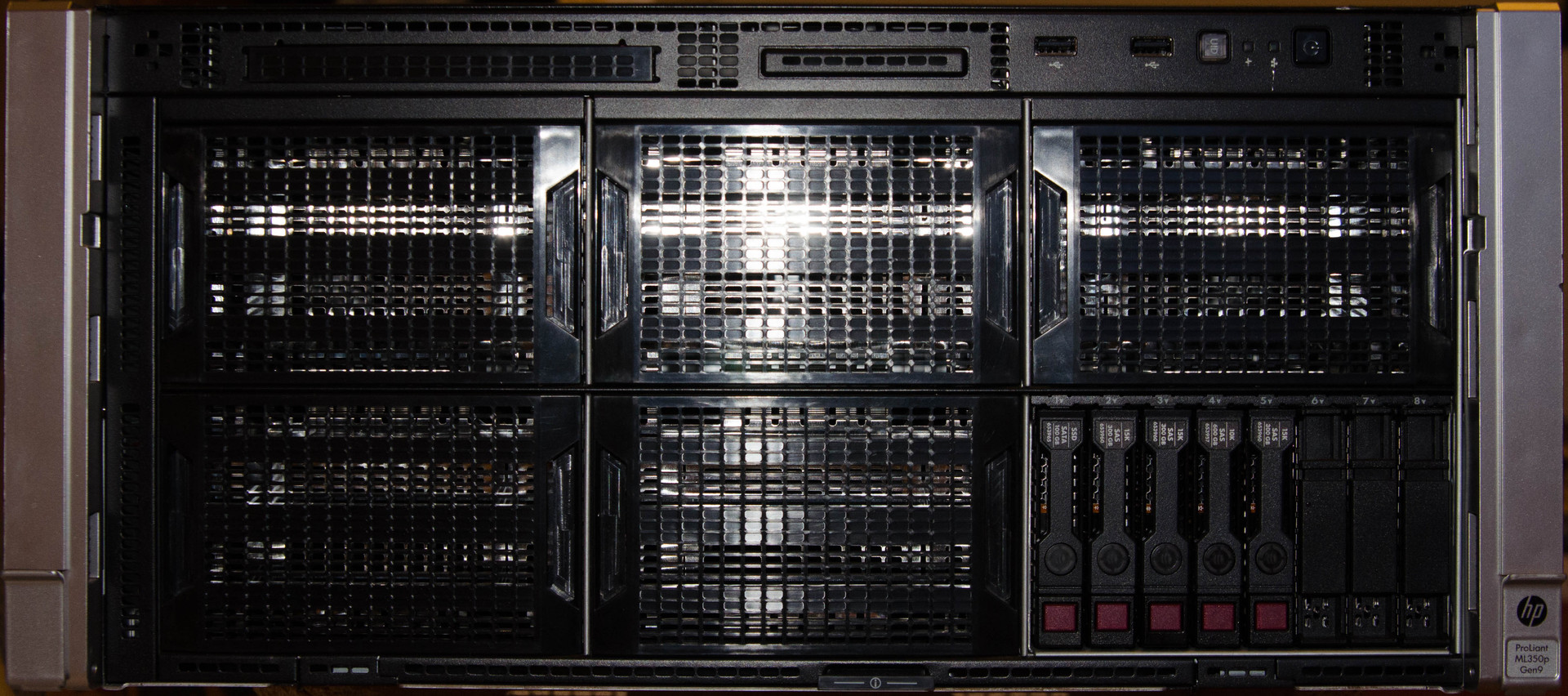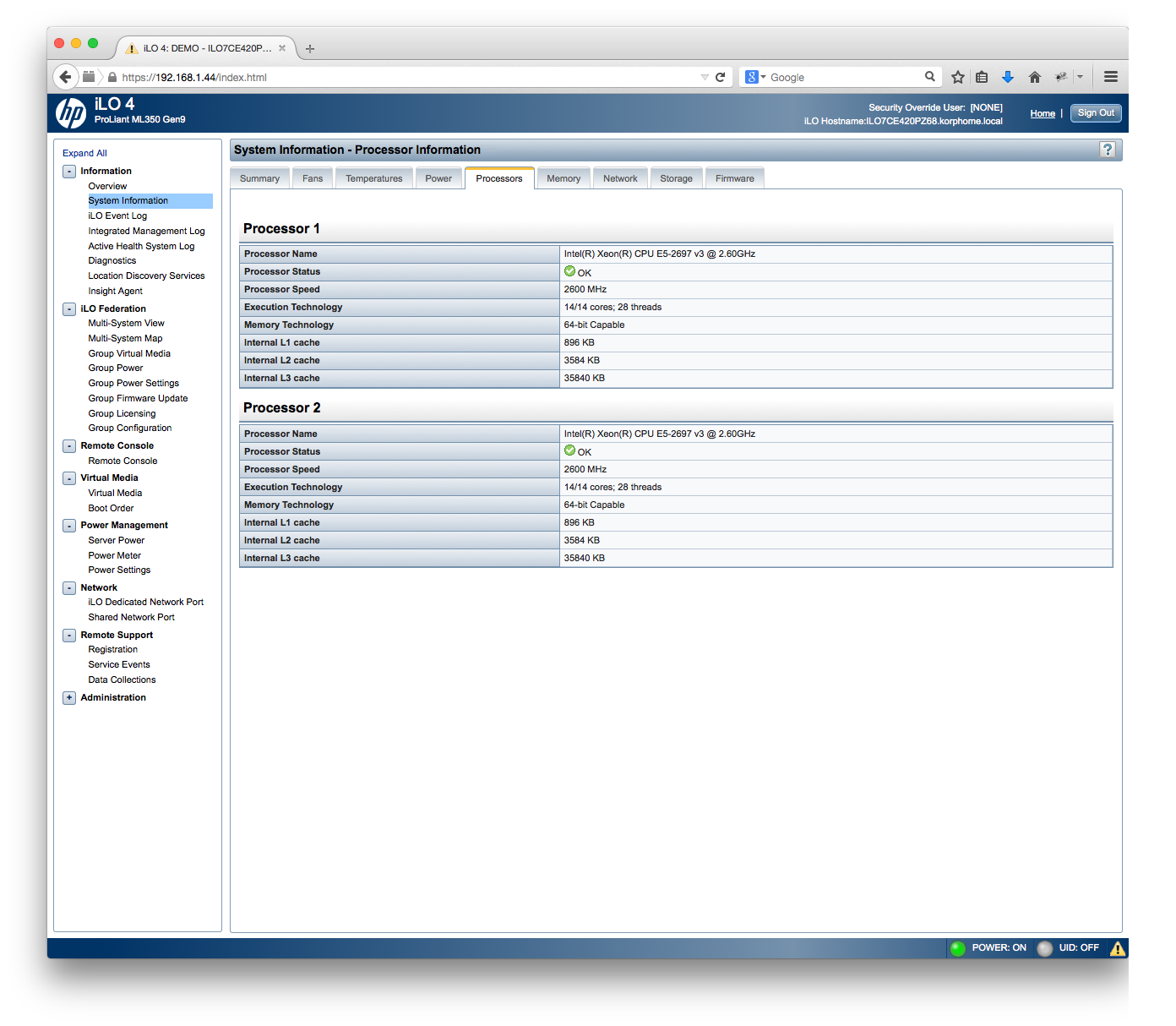HP ProLiant ML350 Gen9 - server with insane extensibility
We publish an overview of the new HP ProLiant ML350 Gen9 server from Evgeny KorP Elizarov
At the end of 2014, the big three server manufacturers announced new server models. HP has introduced more than 10 updated server models, among which was the HP ProLiant ML350 Gen9.

')
The main features of the new server are:
- Support for new generation Intel Xeon E5-2600 v3 processors
- HP SmartMemory DDR4 memory support
- Updated HP Smart Array P440ar Controller (12 Gb / s SAS)
- An updated HP Dynamic Smart Array controller that supports collaboration with the HP Flexible Smart Array and Smart SAS HBA controllers.
Honestly, this is the first time I review servers from HP. I have been able to work only with the already outdated models of the Gen5 generation, which are still working in our rack. The development of servers has reached the point that there is no point in comparing the servers of the “Big Three” to each other, all of them are made qualitatively and at a high level. Another thing, if it is a server of less famous and popular manufacturers, such as Huawei, who are still just “catching up” with the leaders in the quality of performance and equipment. But today I will talk about HP ML350 Gen9.
The server can be installed in a rack, using the optional rail kit, and can be used as a tower, thanks to the legs of the kit.
Specifications:
For what I personally love multi-server, so it is for the space inside. Of course, a dense lineup of 2U gives you a lot of computational power per unit, but very often it happens that the space occupied in the rack is not something limiting, but a good cooling of components and convenient access to them is very important.

This will be especially true if you have a large number of expansion cards for use of which HP ML350 Gen9 is perfect. Up to 9 PCIe 3.0 slots will allow you to use various expansion cards, be it FC or PCI-E SSD, and support for power supplies up to 1400W will ensure all this reliable power. The spacious case and powerful coolers will provide an excellent level of cooling.

Coolers can be installed up to 8 pieces.
The server is positioned as a workgroup server and a server for special applications. Most likely, this model will be of interest to companies that are planning active growth in a short time, then the use of HP ML350 Gen9 will be really justified. But in some cases, this server can be used as a powerful workstation to process video content, for example. Fortunately, the cooling system in HP servers, starting somewhere from the Gen5 generation, is sufficiently productive even at low revolutions of the coolers, due to which the noise level in the room is minimal. I myself have an HP DL360 G6 server in my apartment, which is completely unnoticeable in terms of noise emitted against household appliances, even at night.
On the front panel you can see 6 baskets under the HDD, in our test sample one basket was installed under 2.5 "disks.

And perhaps the main feature of this server is the ability to install up to 48 SFF disks, which none of the competitors can offer at the moment. You can organize disks in a variety of ways - hang each disk crate on a separate controller for maximum IOPS or all together on two controllers with SAS-Expander - for budget large-capacity logical volumes. There is also a built-in SATA controller (available on all models). In general, in terms of the disk subsystem, the expansion possibilities are extremely wide and interesting for any application.
The slides for the discs themselves received an update back in the 8th generation, which I “missed” for myself, compared to Gen7 and earlier - they have become more compact and much more conveniently inserted now, and the new “click” button of the disc from the basket too very comfortable.

On the back panel is a standard set of ports: USB (including 3.0), network interfaces, iLO port.

In fact, it is extremely difficult to write about the platform itself. From a constructive point of view, servers have long reached a very high level of quality and their use and communication with them delivers only positive emotions. Therefore, I will continue the story about the thing that HP Server’s HP Integrated Lights-Out (iLO) server functions provide.

Various technologies used in iLO allow you to control the temperature indicators of the server and the status of the cooling fans. The integrated Active Health System (AHS) component monitors server activity, health logs, configurations, various server indicators in real time, etc., which allows you to quickly collect diagnostic information and allow you to send this data to the company using Insight Online or Insight Remote Support 7.x HP in case of problems with the equipment.

The function iLO Federation also appeared - the ability to manage several servers with iLO on one server and monitor their status - this function is extremely useful for those who have to administer and monitor a large amount of equipment. Well, since it's already 2015, it’s not without mobile technology here. Mobile applications for Android and iOS allow you to access the server from your mobile phone.

Also in iLO4 has its own API, which allows you to quickly deploy multiple servers.
For me personally, in remote control systems, for complete happiness and convenience, perhaps one function is missing — the ability to check and download new firmware for the server, the controller, and the control system itself directly from the web interface. I do not know why the manufacturers have not yet implemented this functionality, because in order to download all this on the site, you do not need to register a server or something else, i.e. in fact, this is not done for data protection purposes. But this could greatly facilitate server upgrades. After all, this is implemented using the HP Smart Update Manager, but this requires its installation on the host OS. But however, SUM is tightly integrated with iLO and can, for example, package updates on any number of servers in parallel using iLO Federation.
Still, the choice of brand for the server being purchased comes down more to personal preferences (to the same control system, for example) or restrictions imposed by the purchasing department. Still, these are not specific platforms on Power Architecture and everything is not limited by the technical capabilities of a particular brand. Upgrading servers this fall is largely due to the transition to Intel v3 processors, DDR4 memory, and new chipsets, but it also didn’t do without small killer features. The rest is good old HP.
Posted by: KorP
At the end of 2014, the big three server manufacturers announced new server models. HP has introduced more than 10 updated server models, among which was the HP ProLiant ML350 Gen9.

')
The main features of the new server are:
- Support for new generation Intel Xeon E5-2600 v3 processors
- HP SmartMemory DDR4 memory support
- Updated HP Smart Array P440ar Controller (12 Gb / s SAS)
- An updated HP Dynamic Smart Array controller that supports collaboration with the HP Flexible Smart Array and Smart SAS HBA controllers.
Honestly, this is the first time I review servers from HP. I have been able to work only with the already outdated models of the Gen5 generation, which are still working in our rack. The development of servers has reached the point that there is no point in comparing the servers of the “Big Three” to each other, all of them are made qualitatively and at a high level. Another thing, if it is a server of less famous and popular manufacturers, such as Huawei, who are still just “catching up” with the leaders in the quality of performance and equipment. But today I will talk about HP ML350 Gen9.
The server can be installed in a rack, using the optional rail kit, and can be used as a tower, thanks to the legs of the kit.
Specifications:
| CPU | 1 or 2 Intel Xeon E5-2600v3 processor |
| Memory | 24 DIMM DDR4 slots |
| Maximum amount of memory | Up to 768 GB |
| Storage System | Up to 48 SFF or 24 LFF |
| Form factor | 5U |
| Power supplies | Up to 4 power supplies: 500W, 800W or 1400W |
For what I personally love multi-server, so it is for the space inside. Of course, a dense lineup of 2U gives you a lot of computational power per unit, but very often it happens that the space occupied in the rack is not something limiting, but a good cooling of components and convenient access to them is very important.

This will be especially true if you have a large number of expansion cards for use of which HP ML350 Gen9 is perfect. Up to 9 PCIe 3.0 slots will allow you to use various expansion cards, be it FC or PCI-E SSD, and support for power supplies up to 1400W will ensure all this reliable power. The spacious case and powerful coolers will provide an excellent level of cooling.

Coolers can be installed up to 8 pieces.
The server is positioned as a workgroup server and a server for special applications. Most likely, this model will be of interest to companies that are planning active growth in a short time, then the use of HP ML350 Gen9 will be really justified. But in some cases, this server can be used as a powerful workstation to process video content, for example. Fortunately, the cooling system in HP servers, starting somewhere from the Gen5 generation, is sufficiently productive even at low revolutions of the coolers, due to which the noise level in the room is minimal. I myself have an HP DL360 G6 server in my apartment, which is completely unnoticeable in terms of noise emitted against household appliances, even at night.
On the front panel you can see 6 baskets under the HDD, in our test sample one basket was installed under 2.5 "disks.

And perhaps the main feature of this server is the ability to install up to 48 SFF disks, which none of the competitors can offer at the moment. You can organize disks in a variety of ways - hang each disk crate on a separate controller for maximum IOPS or all together on two controllers with SAS-Expander - for budget large-capacity logical volumes. There is also a built-in SATA controller (available on all models). In general, in terms of the disk subsystem, the expansion possibilities are extremely wide and interesting for any application.
The slides for the discs themselves received an update back in the 8th generation, which I “missed” for myself, compared to Gen7 and earlier - they have become more compact and much more conveniently inserted now, and the new “click” button of the disc from the basket too very comfortable.

On the back panel is a standard set of ports: USB (including 3.0), network interfaces, iLO port.

In fact, it is extremely difficult to write about the platform itself. From a constructive point of view, servers have long reached a very high level of quality and their use and communication with them delivers only positive emotions. Therefore, I will continue the story about the thing that HP Server’s HP Integrated Lights-Out (iLO) server functions provide.

Various technologies used in iLO allow you to control the temperature indicators of the server and the status of the cooling fans. The integrated Active Health System (AHS) component monitors server activity, health logs, configurations, various server indicators in real time, etc., which allows you to quickly collect diagnostic information and allow you to send this data to the company using Insight Online or Insight Remote Support 7.x HP in case of problems with the equipment.

The function iLO Federation also appeared - the ability to manage several servers with iLO on one server and monitor their status - this function is extremely useful for those who have to administer and monitor a large amount of equipment. Well, since it's already 2015, it’s not without mobile technology here. Mobile applications for Android and iOS allow you to access the server from your mobile phone.

Also in iLO4 has its own API, which allows you to quickly deploy multiple servers.
For me personally, in remote control systems, for complete happiness and convenience, perhaps one function is missing — the ability to check and download new firmware for the server, the controller, and the control system itself directly from the web interface. I do not know why the manufacturers have not yet implemented this functionality, because in order to download all this on the site, you do not need to register a server or something else, i.e. in fact, this is not done for data protection purposes. But this could greatly facilitate server upgrades. After all, this is implemented using the HP Smart Update Manager, but this requires its installation on the host OS. But however, SUM is tightly integrated with iLO and can, for example, package updates on any number of servers in parallel using iLO Federation.
Still, the choice of brand for the server being purchased comes down more to personal preferences (to the same control system, for example) or restrictions imposed by the purchasing department. Still, these are not specific platforms on Power Architecture and everything is not limited by the technical capabilities of a particular brand. Upgrading servers this fall is largely due to the transition to Intel v3 processors, DDR4 memory, and new chipsets, but it also didn’t do without small killer features. The rest is good old HP.
Posted by: KorP
Source: https://habr.com/ru/post/248047/
All Articles